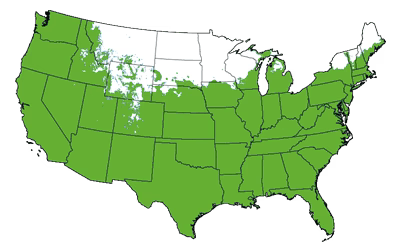Chicago Hardy Fig Tree
Plant Health Guaranteed
Your Plants are Guaranteed
Your Plants are Guaranteed
Your plants are guaranteed to arrive happy & healthy with our 30 Day Plant Promise. Your order will arrive healthy and stay healthy while they adapt to your climate. If not, just call us at (704) 443-8256.
Free Shipping on All Orders
Free Shipping on All Orders
Free shipping on all orders. Your plants will ship out the next business day... expertly packed so that your plants will arrive happy and healthy!
Planting & Care
Planting & Care
|
The Chicago Hardy Fig Tree thrives in Zones 5-10 
If you live in the green area above, we recommend the Chicago Hardy Fig Tree. |
||
| Your Growing Zone | ||
| Recommended Zones | 5-10 | |
| Mature Height | 15-30 ft. | |
| Mature Width | 15-30 ft. | |
| Cannot Ship To | AZ, OR | |
| Sunlight | Full Sun | |
| Botanical Name | Ficus carica 'Chicago Hardy' | |
|
The Chicago Hardy Fig Tree thrives in Zones 5-10 
If you live in the green area above, we recommend the Chicago Hardy Fig Tree. |
|
| Your Growing Zone | |
| Recommended Zones | 5-10 |
| Mature Height | 15-30 ft. |
| Mature Width | 15-30 ft. |
| Cannot Ship To | AZ, OR |
| Sunlight | Full Sun |
| Botanical Name | Ficus carica 'Chicago Hardy' |
Description
Description
Chicago Hardy Fig Tree – A Cold-Hardy, Sweet Delight for Your Garden
Enjoy the taste of fresh, homegrown figs no matter where you live with the Chicago Hardy Fig Tree. Famous for its ability to withstand colder climates, this resilient fig tree produces abundant crops of sweet, delicious figs even in areas where winters are harsh. With its rich, purple-brown fruit and compact size, the Chicago Hardy Fig is perfect for growing in both small gardens and large yards. Plus, its easy-care nature and ornamental appeal make it a fantastic addition to any landscape or container garden.
Key Benefits of Chicago Hardy Fig Tree
- Cold-Hardy and Resilient: The Chicago Hardy Fig thrives in USDA Zones 5-10, making it one of the most cold-tolerant fig varieties. Even in colder regions, it can endure freezing temperatures and bounce back in the spring, producing fruit year after year.
- Sweet, Delicious Figs: The Chicago Hardy Fig produces medium-sized, dark purple to brown figs with a sweet, jam-like interior. These figs are perfect for fresh eating, preserving, or adding to desserts and recipes.
- Compact and Productive: With a manageable size of 10-15 feet tall, the Chicago Hardy Fig fits well in smaller yards or patio spaces, yet still delivers an impressive yield of fruit each season.
- Multiple Harvests: This fig tree provides two harvests per year—one smaller crop in early summer and a larger crop in late summer to early fall—so you can enjoy fresh figs throughout the growing season.
- Low-Maintenance: Once established, this fig tree is easy to care for and drought-tolerant, making it a great option for both experienced and novice gardeners.
Ideal Placement and Uses
The Chicago Hardy Fig Tree is versatile and can enhance any garden or home space with its beauty and fruitfulness:
- Backyard Orchard: Grow your own figs as part of a backyard orchard or edible landscape for an abundant supply of fresh, homegrown fruit.
- Container Gardening: This compact tree grows well in large containers, making it ideal for patios, balconies, or small spaces where you can enjoy fresh figs right at your doorstep.
- Urban and Suburban Gardens: Perfect for both urban gardens and suburban yards, the Chicago Hardy Fig’s cold tolerance and compact size make it a top choice for colder climates.
- Standalone Specimen: Use it as an ornamental feature in your landscape, where its broad, lush green leaves and attractive form add beauty even when it’s not producing fruit.
Growing Tips for Chicago Hardy Fig Tree
The Chicago Hardy Fig Tree is easy to grow and care for, even in less-than-ideal climates. Follow these tips for a healthy, productive tree:
- Sunlight: Plant in full sun for the best fruit production. The more sunlight it receives, the better the quality and sweetness of the figs.
- Soil: This fig tree prefers well-draining soil, though it can adapt to various soil types, including loamy or sandy soils. Amending the soil with compost can improve drainage and nutrient content.
- Watering: Water regularly during the first year to establish a strong root system. Once mature, the Chicago Hardy Fig is drought-tolerant but benefits from occasional deep watering during dry spells.
- Pruning: Minimal pruning is needed, but you can shape the tree in late winter or early spring by removing dead or damaged branches. Pruning can help encourage better air circulation and more fruiting.
- Cold Protection: In colder regions (Zones 5-6), consider mulching around the base of the tree or providing frost protection during the winter. If growing in a container, bring the tree indoors or into a sheltered area during extreme cold.
Enjoy Fresh Figs with the Cold-Hardy Chicago Hardy Fig Tree
The Chicago Hardy Fig Tree is the perfect addition to any garden, offering sweet, homegrown figs even in colder climates. Known for its cold-hardiness and ease of growth, this low-maintenance tree produces delicious, high-quality figs season after season. Whether you're an experienced gardener or a beginner, the Chicago Hardy Fig Tree delivers productivity and charm to your outdoor space. Plus, enjoy the convenience of delivery to your door. Shop now and bring this resilient fruit tree home today!





